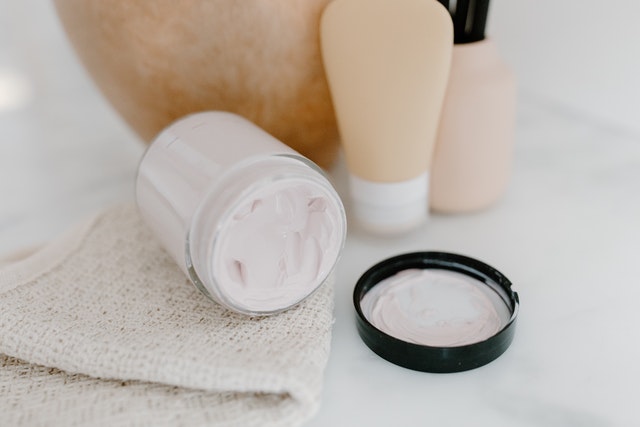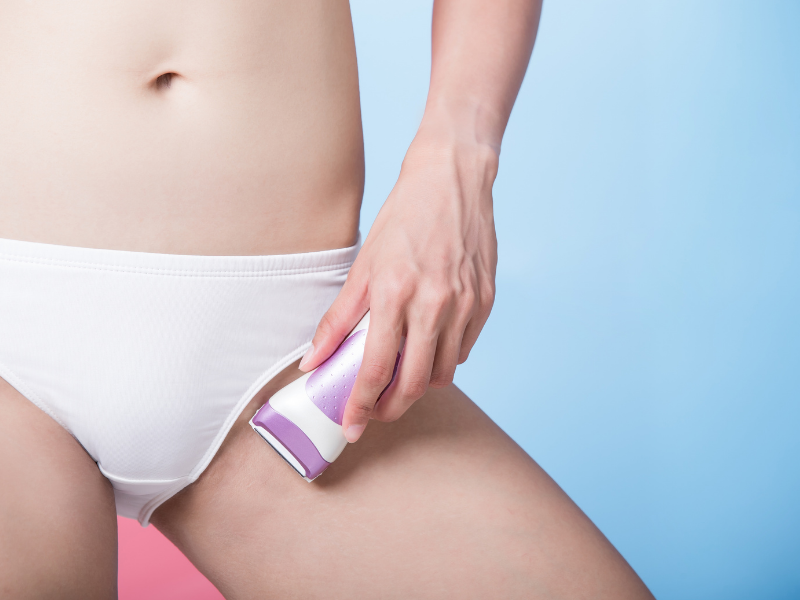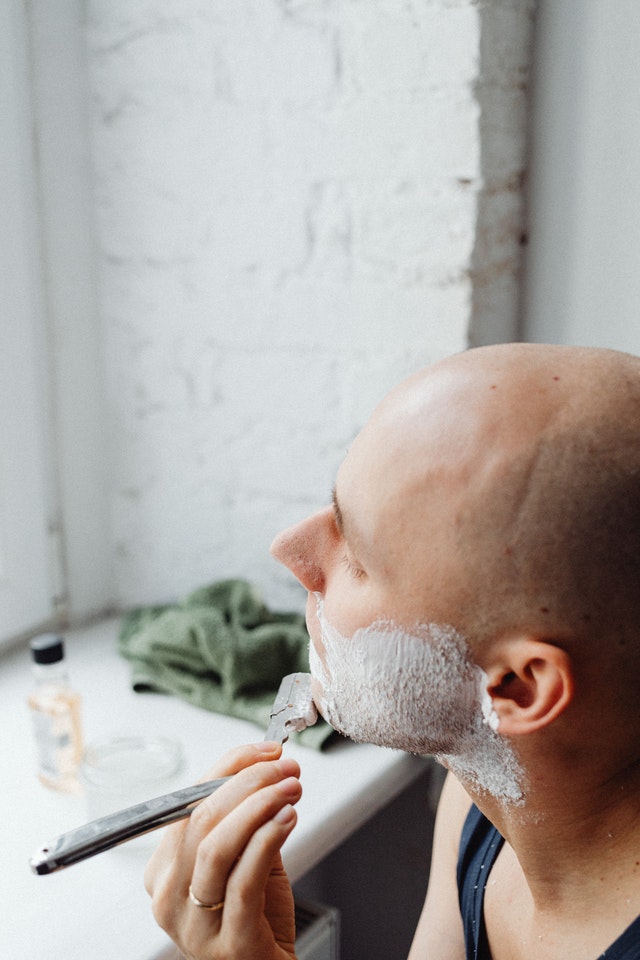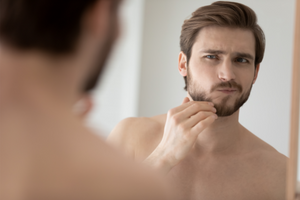Razor bumps, medically known as pseudofolliculitis barbae, are common. The condition is caused by shaving, which causes curly hair to grow back into the skin. Razor bumps most often affect men and women with coarse or curly hair.
While You can treat the bumps with prescription medications, there are also a few over-the-counter (OTC) remedies that can be effective. Here we will tell you about the five best OTC remedies for razor bumps and why they work.

Since ancient times, Aloe Vera has been used for various skin conditions because of its numerous benefits. Aloe vera gel is naturally:
One of the best treatments for razor bumps at home is pure aloe vera gel or products made with natural aloe vera. These products can help reduce the appearance of razor bumps and provide instant relief.
Witch hazel is an all-natural astringent and antiseptic made from the bark and leaves of the Hamamelis virginiana plant. Native Americans used witch hazel medicinally for ailments, including colds, infections, and liver conditions. Today, you can see benefits for yourself by using witch hazel on various skin conditions, including razor bumps.
Razor bumps are caused when hair grows back into the skin after being shaved. That creates inflammation, redness, and itching in the epidermis. Witch hazel soothes and calms the skin. Meanwhile, its anti-inflammatory properties reduce redness and swelling from razor bumps.
Witch hazel products are great to always have on hand if you frequently experience mild to moderate razor bumps. For more serious cases of razor bumps, you might need to check with a physician before applying any topical treatment.
Tea tree oil is a natural remedy that you can use to treat razor bumps at home. With razor bumps, the hair follicles become irritated. Tea tree oil has antiseptic and anti-inflammatory properties that can calm folliculitis symptoms.
There is another reason to consider tea tree oil or products containing tea tree oil after shaving. Razors often cause tiny nicks and cuts on the skin. Tea tree oil may help prevent infection because it is believed to be antibacterial.
You can buy tea tree oil at most drugstores or online. Apply a few drops of oil directly to the affected area, and massage it gently. Do this two or three times a day until the razor bumps have disappeared. If you are using tea tree oil for the first time, start by applying a small amount to a test area to check for sensitivity. You can also add tea tree oil to a bath or shower.
Salicylic acid is a beta-hydroxy acid that works by breaking down the cells in the outer layer of the skin. It leads to the shedding of dead skin cells and helps unclog pores.
Salicylic acid is a topical medicine used to treat acne, psoriasis, calluses, corns, warts, and other skin conditions. Salicylic acid is available OTC without a prescription in up to 2% concentrations.
Benzoyl peroxide is an active ingredient found in many OTC acne medications. It is also the key ingredient in many razor bump treatments. It also breaks down keratin cells in the outer skin layers, causing dead skin to peel off. That opens and exposes ingrown hair cysts, which helps dry and heal them.
Benzoyl peroxide helps unblock pores, which can help prevent and treat razor bumps.
There are many benzoyl peroxide-based treatments available for razor bumps. Some are available as creams, gels, or washes. Others are available as ointments or lotions. Choose the one that works best for you.
Although razor bumps are a common problem for men and women who shave, you don’t have to live with them. For a mild case, try an over-the-counter treatment for razor bumps to reduce itching and minimize redness.
If you try these OTC treatments but don’t see improvement, talk with one of our expert doctors. Razor Bumps, Inc. offers video consultations with expert doctors to treat razor bumps. We will help you get rid of those pesky razor bumps for good!
We know that razor bumps can be embarrassing and frustrating. Let us help you get rid of them for good. We offer a video consultation with a doctor who can help you get your confidence back.
Contact us now for your low-cost appointment that your insurance may cover!
Disclaimer: The contents of this article are for informational purposes only and do not constitute medical advice. The information, graphics, and images on this site are not intended to substitute diagnosis or treatment by a medical professional. Always seek the advice of a licensed physician for any questions you may have regarding a specific condition.
“Aloe Vera”. bcm.edu. Accessed June 3, 2022.
“Benzoyl Peroxide”. ncbi.nlm.nih.gov. Accessed June 3, 2022.
“Salicylic Acid”. medlineplus.gov. Accessed June 3, 2022.
“Tea Tree Oil”. mayoclinic.org. Accessed June 3, 2022.
“Witch Hazel”. drugs.com. Accessed June 3, 2022.
You think you’ve just finished shaving your pubic area, but you notice something. It’s red, itchy, and painful. You have a razor bump in your pubic area.
Razor bumps are common for many people who shave the sensitive skin of their genitals, so if you’re dealing with them, don’t beat yourself up about it. If you get a case of razor bumps around the pubic area, you can treat it right away and take steps to prevent future razor bumps.
Here’s how to treat razor bumps in the pubic area once they pop up (and how to prevent them in the first place).

Razor bumps are small, red bumps that can appear after shaving. They’re called “razor bumps” because ingrown hairs from shaving cause them. These bumps develop when hair shafts become trapped beneath the skin’s surface. Ingrown hairs can be painful, itchy, and embarrassing, especially in a sensitive area like your pubic region!
Yes! If you’ve ever shaved or waxed the areas around your genitals, you’re at risk of getting razor bumps. The good news is that if you follow these tips for preventing razor bumps in the future, they’ll be less likely to appear on your body again.
These tips will help keep your skin in good condition and hopefully prevent problems from razor bumps.
If you already notice a red, bumpy rash on your skin, it is too late for prevention. It’s time to focus on treatment.
Make sure to wash the area gently with warm water and soap each day. That will help to cleanse your skin and prevent infection.
Apply a topical cream that soothes razor burn or ingrown hairs, such as aloe vera gel or witch hazel solution.
Apply a warm compress to the affected area for 10 minutes, up to three times per day, to increase blood flow to the area.
If your symptoms don’t go away or become worse, talk to a doctor about other treatments or prescription medications.
If you get razor bumps, treat them right away and take steps to prevent them from coming back.
Razor bumps are no fun, but they’re also nothing to be embarrassed about. Lots of people get them, and you can take steps to prevent them and treat them. Now that you know how razor bumps form and some tips for getting rid of them, give the methods we covered a try!
If you try to relieve razor bumps on your own, but they won’t go away, it’s time to talk to a medical professional.
If razor bumps have you bothered and you want to talk to an online doctor, Razor Bumps, Inc.’s board-certified physicians are available now through easy virtual video visits. Find out more by chatting with us now.
Disclaimer: The contents of this article are for informational purposes only and do not constitute medical advice. The information, graphics, and images on this site are not intended to substitute diagnosis or treatment by a medical professional. Always seek the advice of a licensed physician for any questions you may have regarding a specific condition.
Razor bumps can be a bother. When they show up, you want them gone fast.
Also known as pseudofolliculitis barbae, razor bumps are small red bumps that can occur after shaving. They make your skin look bumpy and feel irritated. When left alone to heal and given proper skincare, razor bumps typically last for about 2-3 weeks. However, severe cases can go on for months.
Razor bumps are a common problem for men who shave their faces regularly, but they can affect women too. In this article, we’ll take a look at what razor bumps are, how to get rid of them, how long they last, and most importantly: how to prevent them from popping up in the first place. Read on to learn more!
After shaving, you may have seen these bumps on your face or neck and wondered how long they’d last. Razor bumps can be frustrating. These ingrown hairs can range from mildly irritating to extremely painful and unsightly.

Razor bumps are caused by ingrown hairs (also called pseudofolliculitis barbae), which develop when hair shaves off unevenly and curls back into the skin instead of growing out the way it should. Mild cases of razor bumps will resolve in one to two weeks. Unfortunately, more severe cases may take much longer to heal. Sometimes, razor bumps cause permanent scarring that does not go away. The resulting irritation looks like small pimples that don’t go away with time or regular cleaning.
Luckily there are steps you can take to reduce razor bumps.
If you want to prevent razor bumps, here’s what you need to know:
Folliculitis is a skin condition resulting from ingrown hairs. It’s caused by shaving, which damages your hair follicles, making it easier for bacteria to grow inside them and cause inflammation.
Ingrown hairs are common in the armpits, groin area and face due to these areas being shaved most often. The inflammation and redness present on the skin may last for up to two weeks until the hair falls out or grows back in its natural direction, which will leave you feeling smooth again!
Common causes of razor bumps include shaving too close to the skin and using blades that cut too closely. Razor bumps can also result from shaving in the direction the hair grows. Shaving in this way leaves behind tiny hairs, which then become ingrown hairs when you attempt to push them back out through subsequent shaves. To avoid this, try shaving in the opposite direction of your hair growth (against it).
When it comes to how long razor bumps last and how they’re treated, there are a few factors at play:
If you take care of your skin and protect it from further injury, razor bumps will heal in 2-3 weeks.
You can prevent razor bumps by selecting the right razor and using proper shaving techniques.
The best method is shaving in the direction of hair growth. Avoid using dull razor blades with too much pressure or shaving in one direction without changing your angle after every stroke.
You should also leave your hair alone for long periods to avoid irritation. Trimming or shaving only when necessary will also help reduce irritation by preventing overgrowth of ingrown hairs and keeping the area from becoming irritated from constant grooming.
As you can see, there are many ways to prevent razor bumps from happening. If you follow these tips and strategies, you will be able to avoid razor bumps with ease.
It is important to note that every person’s skin is different, and what works for one may not work for another. You should try out different methods to find one that works best with your skin type and hair texture.
The best treatment for razor bumps is exfoliation and pushing hairs out of the skin through trimming or shaving only when necessary.
Exfoliating your skin will help remove dead skin cells that can irritate and reduce ingrown hairs.
Try using an over-the-counter exfoliant cream for sensitive skin.
If razor bumps persist, you need to talk to a doctor about your skin condition.
You can avoid razor bumps if you’re conscious of how you shave.
Hopefully, you better understand razor bumps and what to do about them. To keep razor bumps from sticking around for two to three weeks, you should try to prevent them altogether. Be sure to follow these simple steps for a safe shave.
Disclaimer: The contents of this article are for informational purposes only and do not constitute medical advice. The information, graphics, and images on this site are not intended to substitute diagnosis or treatment by a medical professional. Always seek the advice of a licensed physician for any questions you may have regarding a specific condition.

Pseudofolliculitis barbae is a common skin condition that many adults will face at some point in their lives. With so many people affected, you might wonder how it is diagnosed.
Pseudofolliculitis barbae is typically diagnosed by physical examination by a licensed healthcare provider, such as a doctor or advanced nurse practitioner. Medical tests, including studying skin tissue samples under a microscope in a laboratory, may also aid in the physician’s diagnosis.
So how does a doctor examine pseudofolliculitis barbae? And how can someone find a physician to treat this problem? Read on to find out.
Want to speak to a board certified physician? Book an appointment today!
Anyone who shaves is at risk of developing "shave bumps," "razor bumps," or ingrown hairs. But African American men are affected most. Studies show that todate.com/contents/pseudofolliculitis-barbae#H87492034">between 45% and 83% of African American men who shave will develop pseudofolliculitis barbae. Men of other ethnicities and women too can experience this problem. It most often appears in the face but can also show up under the arms, in the bikini area, or the legs.
Physicians or practitioners can diagnose pseudofolliculitis barbae tologic-disorders/hair-disorders/pseudofolliculitis-barbae#v38068013">by physical examination at a simple doctor's visit. With any physician encounter, the first part of the diagnosis will be an interview.
The doctor will ask the patient questions to figure out what is wrong or what the complaint is. Some common questions a provider might ask when diagnosing pseudofolliculitis barbae are:
In addition to taking a history, the doctor will observe the skin for any changes. Small red to-avoid-bikini-line-bumps-2/">bumps, tenderness, and itching are all signs that could alert the doctor to a possible diagnosis of pseudofolliculitis barbae.
Finding a doctor for pseudofolliculitis barbae is easier than ever. A dermatology or skin specialist referral may not be necessary. Many primary care doctors can diagnose and treat this problem with a quick check-up.
There is also good news for patients who do not have a doctor. When someone doesn't have a doctor or is unsure how to find one, a virtual physician is a great option. Online doctor visits are often less expensive than going to a doctor's office. And in many cases, patients can book them faster. Most virtual physicians offer convenient appointment times, and some even have same-day bookings.
Whether online or in-person, it is best to contact the doctor and ask for an appointment to evaluate a skin condition. Give the doctor as much information as possible. If you think it's pseudofolliculitis barbae, then let the provider know when you book your visit.
A licensed healthcare provider is the only one who can say for sure if a skin rash might be a case of pseudofolliculitis barbae or something more serious. Luckily, an appointment to see a physician can be simple and inexpensive. Relief may be as close as a phone call or video visit today.
Our caring experts can help answer your skin questions. To meet a top board-certified physician, book an appointment today.

Masks have become a permanent accessory for many U.S. workers. Unfortunately, facial hair makes masking difficult. Some workers required to wear personal protective equipment, like respirator masks, find it especially hard. You may even wonder, how can men with full beards wear N95 masks?
An N95 respirator mask is a protective device made to fit tightly against the face to filter 95% of particles from the air entering the nose and mouth. As a result, men with full beards cannot wear N95 masks safely or effectively. Facial hair that comes between the skin and mask edges prevents a tight fit and good seal.
So what can men do if they have facial hair but need respiratory protection? There are options for men in such situations. Read on to find out.
Many jobs require respiratory protection. Here are just a few of the workers that may be required to wear an N95 mask in on-the-job situations.
In many of these jobs, facial hair is not allowed. Therefore, tory?id=69916196" target="_blank" rel="noreferrer noopener">some men choose to shave their facial hair.
Unfortunately for some of these workers, going clean-shaven causes problems. Sometimes shaving causes adverse effects.
The face and neck are sensitive parts of the body. Facial shaving may result in some very uncomfortable skin conditions. Problems created by shaving may include folliculitis, painful skin infections, and hyperpigmentation. For men suffering from significant health conditions like these, limiting or even avoiding shaving may be necessary.
A shaving waiver, also known as a shaving profile or “no-shave waiver,” can help individuals with certain conditions. A shaving profile is a medical release or exemption form. The document, completed by a physician, explains why a man should not be required to shave his face due to health concerns.
Shaving waivers allow men to forgo shaving and get the right respiratory protection for them. Men with facial hair do not have to risk inhaling unsafe vapors.
Some respirator masks do not require a face seal. These types are a better option for bearded employees.
Specifically, positive-pressure respirators worn over facial hair or beards work to filter the air. A hood-and-helmet type mask uses continuous airflow to protect employees.
One example that is available to workers is called the Powered Air Purifying Respirator (PAPR) mask. This loose-fitting respirator uses a blower to pass air through a filter before sending it to the face. Typically, PAPR masks are lightweight and battery-operated. Also, PAPR masks do not require Fit-Testing.
One drawback is their cost. Most employees would not want to invest in their own PAPR. Those looking for a PAPR respirator can purchase a simple version online for around $100. However, some are upwards of $1000. Batteries and chargers may double the expense.
Although these masks are more costly, they offer superior protection. According to tomerics/" target="_blank" rel="noreferrer noopener">this article by the Center for Disease Control and Prevention (CDC), a PAPR mask may offer an Assigned Protection Factor (APF) of 1000, where an N95 respirator only has an APF of 10. The higher the protection factor, the safer it is.
The use of a PAPR mask does require a physician’s medical evaluation. It is a respirator, and therefore OSHA’s requirements to evaluate an employee before requiring the mask applies to this type.
Men with full beards can find respiratory protection that won’t cause health problems or skin conditions. The first step is a medical evaluation by a licensed physician.
Men interested in finding out if a PAPR mask or shaving waiver for their employer would be right for them should talk to a doctor.
My Virtual Physician now offers consultations for shaving waivers in some states. Fill out the contact form below to speak to one of our board-certified physicians about a shaving waiver.